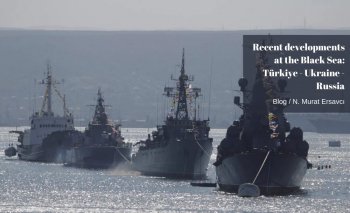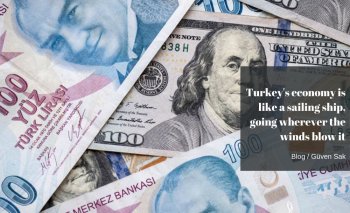Commentaries
Fatih Özatay, PhD - [Archive]
It is easy to support the status quo; it is radicalism that necessitates talent 17/10/2010 - Viewed 1174 times
We can live the moment and be happy. But take a look at the previous five decades, do we see a pleasant picture?
In the first day of the 'Media's Radical Revolution' the question below appears in one's mind: If Turkey was to translate the attempt in the media into the economy, what was the step to take? But before that we had better pose this question: Does Turkey actually need an economic revolution?
First, let me focus on the 'moment': let me compare Turkey's pre- and post-crisis growth performance with other selected countries. I am referring to the report prepared by two research associates at TEPAV in September (Sarp Kalkan and Ekrem Cünedioğlu: Did Turkey overcome the crisis in the second quarter and outpace other countries? TEPAV Policy Note; http://www.tepav.org.tr/tr/yayin).
The report examines the gross domestic product (GDP) figures for thirty five countries, which includes developed countries as well as countries with similar GDP level with Turkey. These selected countries are classified under four groups according to their performance during the crisis and during the recovery period: 'Economies growing in the face of the crisis': China, Indonesia, India and Poland. 'Rapid-recoverers': ten countries including Brazil, South Africa and Malaysia. 'slow-recoverers': 7 countries all of which are developed, except Mexico (the list involves the USA, Germany and France. 'Non-recoverers': fourteen countries, all of which are EU countries except Japan and Russia.
Table 1 shows the movement in GDP in these country groups and in Turkey during the global crisis. For comparability purposes, total GDP of each country in the second quarter of 2008 is taken as 100 and figures for other quarters are calculated accordingly. In the trough of the crisis, Turkey performs worse that the other country groups: the fall in GDP is severer in Turkey. The performance in the first three quarters of 2009 resembles that of the 'slow-recoverers' group. In the following period, Turkey assumes a position between 'rapid-recoverers' and 'slow-recoverers'.
Therefore, we can live the moment and be happy. Of course it is essential that this performance is maintained and the year 2011 is not likely to represent a bright picture; but we are not performing badly. So, if we do not focus on the 'moment' and take a look at the previous five decades, do we see a pleasant picture?
Table 2 shows the ratio of GDP per capita in Turkey to GDP per capita in the USA as well as other selected countries. The data is obtained from 'Penn World Tables' which is frequently referred to in research on growth. The database is freely accessible online.
I have used this table before. I refer to it once again today is the specific characteristic of today which I mentioned at the beginning. We should always keep in mind what this table implies. Turkey made no progress in terms of its position against the US; the income gap was never closed. On the other hand, over the same period countries including Ireland and Korea made a significant progress. And similarly China has been demonstrating an impressive performance since 1980s.
Of course some countries encounter a rapid deterioration in terms of their comparative position. However we cannot just look at them and be content from the point we stand at. If we want to accomplish a radical economic revolution, we have to ask ourselves continuously what we need to do to turn the outlook. But, have you ever heard this issue being discussed? Is this issue on the agenda of political parties, prominently the ruling AKP?
It is easy to support the status quo; it is radicalism that necessitates talent.
Table 1 GDP Performance During the Crisis (Quarterly)
|
|
08Q1 |
08Q2 |
08Q3 |
08Q4 |
09Q1 |
09Q2 |
09Q3 |
09Q4 |
10Q1 |
10Q2 |
|
Growing in the face of the crisis |
98.8 |
100 |
101.2 |
102.2 |
103.4 |
104.4 |
105.9 |
107.4 |
109.3 |
111.2 |
|
Rapid-recoverers |
99.9 |
100 |
100.8 |
98.7 |
95.4 |
97.1 |
100 |
101.7 |
102.9 |
105.1 |
|
Slow-recoverers |
99.9 |
100 |
99.7 |
98.6 |
95.5 |
95.4 |
96.3 |
97.2 |
97.6 |
98.8 |
|
Non-recoverers |
99.3 |
100 |
100.3 |
98.1 |
93 |
92.9 |
94.1 |
94.1 |
93 |
94.1 |
|
Turkey |
101.7 |
100 |
99.4 |
93.8 |
88.6 |
92.8 |
96.3 |
98 |
98.5 |
102.1 |
Table 2 Per capita income as a ratio to per capita income in the USA (%, purchasing power parity)
|
|
1960 |
1970 |
1980 |
1990 |
2000 |
2007 |
|
Turkey |
17 |
17,2 |
16,8 |
17,4 |
16,3 |
17,8 |
|
Argentina |
63,2 |
56,8 |
51 |
29,4 |
32,3 |
36,2 |
|
Brazil |
20,9 |
24,5 |
35,2 |
25,6 |
21,5 |
22,1 |
|
China |
3,2 |
2,7 |
3,6 |
5,9 |
10,6 |
19,8 |
|
Ethiopia |
5,6 |
5 |
4,4 |
3 |
2,4 |
2,6 |
|
Ireland |
44,2 |
49,7 |
53,5 |
57,8 |
81,8 |
95,1 |
|
Korea |
10,9 |
14,4 |
22,1 |
40,3 |
48,8 |
54,7 |
|
Egypt |
10,1 |
10,6 |
11,5 |
12,4 |
11,8 |
13,5 |
|
Nigeria |
10,8 |
7,3 |
7,1 |
3,7 |
3,4 |
5,5 |
|
Poland |
- |
27,4 |
32,2 |
24 |
27,4 |
33,9 |
|
Greece |
38,2 |
57,5 |
65,3 |
52,4 |
51,3 |
64,7 |
This commentary was published in Radikal daily on 17.10.2010














